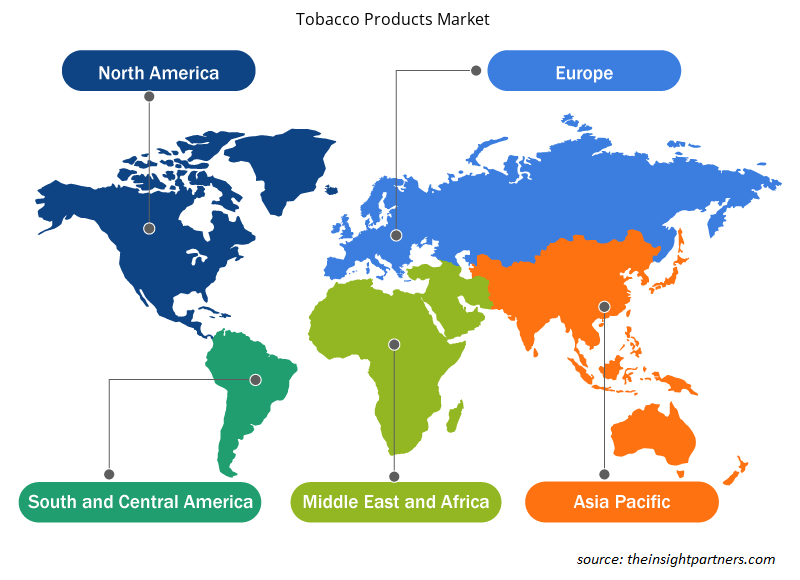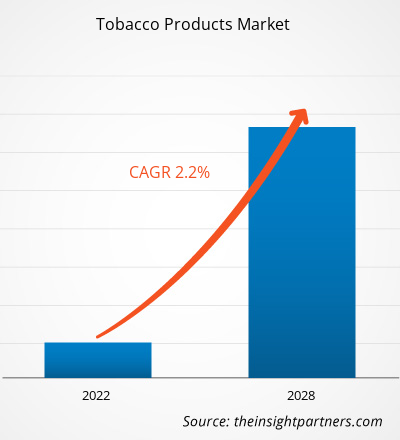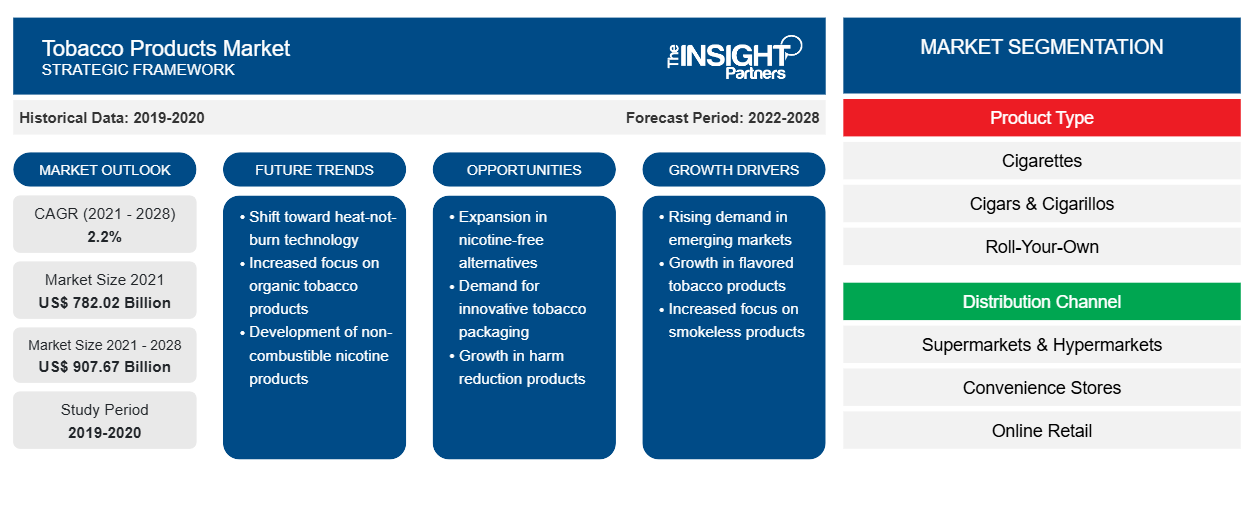Se proyecta que el mercado de productos de tabaco alcance los 907.665,43 millones de dólares estadounidenses en 2028, frente a los 782.022,19 millones de dólares estadounidenses en 2021. Se espera que crezca a una CAGR del 2,2 % entre 2021 y 2028.
Las hojas de tabaco de distintas variedades, como Virginia y Burley, se mezclan para fabricar productos como cigarrillos , puros y cigarrillos, y tabaco para liar. El consumo de tabaco y productos relacionados aumentó en todo el mundo durante la época de desaceleración económica debido a la caída de los mercados bursátiles y las ejecuciones hipotecarias, y al estrés relacionado con los despidos, que impulsaron a muchas personas a buscar refugio en el tabaco. El tabaco es una de las sustancias adictivas más comunes en el mundo. También contribuye a la mayoría de los ingresos fiscales de varias naciones en economías desarrolladas y en desarrollo.
En 2020 , la región de Asia y el Pacífico tuvo la mayor participación en el mercado de productos de tabaco , mientras que se espera que Oriente Medio y África registren una CAGR significativa en el mercado durante el período de pronóstico. Los actores clave que operan en el mercado de productos de tabaco están expandiendo sus operaciones en Oriente Medio y África debido a la base de clientes potenciales, las leyes favorables y el panorama minorista en rápido desarrollo en toda la región.
Personalice este informe según sus necesidades
Obtendrá personalización en cualquier informe, sin cargo, incluidas partes de este informe o análisis a nivel de país, paquete de datos de Excel, así como también grandes ofertas y descuentos para empresas emergentes y universidades.
-
Obtenga las principales tendencias clave del mercado de este informe.Esta muestra GRATUITA incluirá análisis de datos, desde tendencias del mercado hasta estimaciones y pronósticos.
Impacto de la pandemia de COVID-19 en el mercado de productos de tabaco
La pandemia de COVID-19 planteó desafíos sin precedentes para muchos sectores a principios de 2020. Los confinamientos, las restricciones fronterizas, las prohibiciones de viaje, la interrupción de la fabricación y otras medidas de seguridad implementadas por los gobiernos según las directrices de la OMS y los ministerios de salud nacionales obstaculizaron las operaciones de fabricación. Por otro lado, según estudios realizados por el Colegio Americano de Médicos, durante los primeros 16 meses de la pandemia de COVID-19, las ventas de cigarrillos en los EE. UU. fueron mayores de lo previsto. La mayoría de las empresas tabacaleras fueron testigos de un aumento en la demanda de productos de tabaco sin humo o calentados y productos de tabaco para masticar durante la pandemia. Sin embargo, se enfrentaron a una ligera disminución en las ventas minoristas de viajes debido a las prohibiciones de viaje.
Perspectivas del mercado
La creciente demanda de productos de tabaco no combustibles impulsa el crecimiento del mercado
Debido a las crecientes preocupaciones sanitarias relacionadas con el consumo de productos de tabaco combustibles, los gobiernos han alentado a las empresas a introducir varias leyes y regulaciones para controlar el consumo de tabaco. Han aumentado los impuestos sobre el tabaco combustible y reducido los precios del tabaco no combustible. Esto resultó en una mayor aceptación de productos no combustibles, como los cigarrillos electrónicos. Por ejemplo, el gobierno del Reino Unido adoptó un enfoque holístico al aumentar significativamente los impuestos sobre los productos de tabaco combustibles y reducir los impuestos sobre los productos no combustibles. Esto aumentó la adopción de cigarrillos electrónicos en el mercado del Reino Unido, reduciendo significativamente las tasas de prevalencia del tabaquismo en el país. Los fabricantes también han desarrollado productos de tabaco orales, no combustibles o sin humo dentro de la categoría de productos de riesgo reducido (RRP).RRPs) category.
Información sobre el tipo de producto
Según el tipo de producto, el mercado de productos de tabaco se segmenta en cigarrillos, puros y cigarrillos, tabaco para liar y otros. Se prevé que el segmento de otros productos de tabaco registre la CAGR más alta durante el período de pronóstico. Este segmento incluye cigarrillos electrónicos, vaporizadores, snus y productos solubles. La creciente conciencia sobre el daño causado por los productos de tabaco combustibles está impulsando la demanda de productos de tabaco no combustibles, como cigarrillos electrónicos, vaporizadores y productos de tabaco para masticar.
Información sobre el canal de distribución
Según el canal de distribución, el mercado de productos de tabaco se ha segmentado en supermercados e hipermercados, tiendas de conveniencia, venta minorista en línea y otros. Se proyecta que el segmento de venta minorista en línea registre la CAGR más alta del mercado durante el período de pronóstico. La venta minorista en línea ofrece una experiencia de compra conveniente para los usuarios, seguida de una entrega de productos simplificada. Las tiendas minoristas en línea ofrecen una amplia gama de productos con grandes descuentos; además, los consumidores pueden comprar cómodamente los productos deseados de forma remota. Los servicios de entrega a domicilio alientan a una gran cantidad de consumidores a comprar a través de portales de comercio electrónico.
Los actores clave que operan en el mercado de productos de tabaco incluyen Altria Group, Inc.; British American Tobacco plc; Swedish Match AB; ITC Ltd.; Japan Tobacco International; Imperial Brands; Philip Morris Products SA; Vector Group LTD.; Pyxus International, Inc.; y China Tobacco International (HK) Company Limited. Estos actores se dedican al desarrollo de productos con riesgos reducidos para la salud para satisfacer las tendencias emergentes de los consumidores, además de cumplir con los marcos regulatorios. Están involucrados en fusiones y adquisiciones, expansiones comerciales y asociaciones para expandir su participación de mercado.
Perspectivas regionales del mercado de productos de tabaco
Los analistas de Insight Partners explicaron en detalle las tendencias y los factores regionales que influyen en el mercado de productos de tabaco durante el período de pronóstico. Esta sección también analiza los segmentos y la geografía del mercado de productos de tabaco en América del Norte, Europa, Asia Pacífico, Oriente Medio y África, y América del Sur y Central.

- Obtenga datos regionales específicos para el mercado de productos de tabaco
Alcance del informe sobre el mercado de productos de tabaco
| Atributo del informe | Detalles |
|---|---|
| Tamaño del mercado en 2021 | US$ 782.02 mil millones |
| Tamaño del mercado en 2028 | US$ 907,67 mil millones |
| CAGR global (2021-2028) | 2,2% |
| Datos históricos | 2019-2020 |
| Período de pronóstico | 2022-2028 |
| Segmentos cubiertos |
Por tipo de producto
|
| Regiones y países cubiertos |
América del norte
|
| Líderes del mercado y perfiles de empresas clave |
|
Densidad de actores del mercado de productos de tabaco: comprensión de su impacto en la dinámica empresarial
El mercado de productos de tabaco está creciendo rápidamente, impulsado por la creciente demanda de los usuarios finales debido a factores como la evolución de las preferencias de los consumidores, los avances tecnológicos y una mayor conciencia de los beneficios del producto. A medida que aumenta la demanda, las empresas amplían sus ofertas, innovan para satisfacer las necesidades de los consumidores y aprovechan las tendencias emergentes, lo que impulsa aún más el crecimiento del mercado.
La densidad de actores del mercado se refiere a la distribución de las empresas o firmas que operan dentro de un mercado o industria en particular. Indica cuántos competidores (actores del mercado) están presentes en un espacio de mercado determinado en relación con su tamaño o valor total de mercado.
Las principales empresas que operan en el mercado de productos de tabaco son:
- Grupo Altria, Inc.
- Tabaco americano británico plc.
- Partido sueco AB
- Compañía: ITC Ltd.
- Tabaco japonés internacional
Descargo de responsabilidad : Las empresas enumeradas anteriormente no están clasificadas en ningún orden particular.

- Obtenga una descripción general de los principales actores clave del mercado de productos de tabaco
Informe Destacado
- Tendencias progresivas de la industria en el mercado de productos de tabaco para ayudar a los actores a desarrollar estrategias efectivas a largo plazo
- Estrategias de crecimiento empresarial adoptadas para asegurar el crecimiento en mercados desarrollados y en desarrollo
- Análisis cuantitativo del mercado de productos de tabaco de 2019 a 2028
- Estimación de la demanda mundial de productos de tabaco
- Análisis de las cinco fuerzas de Porter para ilustrar la eficacia de los compradores y proveedores que operan en la industria
- Avances recientes para comprender el escenario competitivo del mercado
- Tendencias y perspectivas del mercado, así como factores que rigen el crecimiento del mercado de productos de tabaco
- Asistencia en el proceso de toma de decisiones destacando las estrategias de mercado que sustentan el interés comercial, lo que conduce al crecimiento del mercado.
- Tamaño del mercado de productos de tabaco en varios nodos
- Descripción detallada y segmentación del mercado y la dinámica de la industria tabacalera
- Tamaño del crecimiento en varias regiones con oportunidades de crecimiento prometedoras
- Análisis histórico (2 años), año base, pronóstico (7 años) con CAGR
- Análisis PEST y FODA
- Tamaño del mercado, valor/volumen: global, regional y nacional
- Industria y panorama competitivo
- Conjunto de datos de Excel
Informes recientes
Testimonios
Razón para comprar
- Toma de decisiones informada
- Comprensión de la dinámica del mercado
- Análisis competitivo
- Información sobre clientes
- Pronósticos del mercado
- Mitigación de riesgos
- Planificación estratégica
- Justificación de la inversión
- Identificación de mercados emergentes
- Mejora de las estrategias de marketing
- Impulso de la eficiencia operativa
- Alineación con las tendencias regulatorias























 Obtenga una muestra gratuita para - Mercado de productos de tabaco
Obtenga una muestra gratuita para - Mercado de productos de tabaco